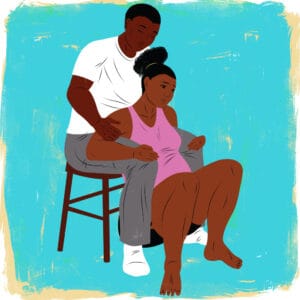The Birth Partner’s Role in Labour and Birth
Sallyann Beresford
Antenatal teacher and Doula
Instagram @theultimatebirthpartner
www.birthability.co.uk
Summary
Whoever you choose to support you in labour has a very important role. Your birth partner, perhaps without realising, has the ability to affect your experience in a multitude of ways. As well as understanding hormones, stages of labour and the mechanics of birth, they will also benefit from knowing what you would like to achieve and why. This article offers some practical tips on how you can both understand a little more about the role a birth partner plays during pregnancy, labour and birth, as well as giving tips and suggestions on having a positive experience.
Choosing Your Birth Partner
Most of you will already have considered who might be at the top of your guest list when it comes to choosing your birth partner, and I’m confident that for most of you, it will be the other parent of your child. Ideally, you want someone who will relax you and definitely not stress you out or bring their own fears or anxieties to your birth experience, as this can hugely impact hormone production. If your local hospital will ‘allow’ more than one birth partner, consider hiring a doula or ask a family member or friend to join you, offering an extra pair of hands to support you both. Prepare them thoroughly for what you want to achieve and be clear on the difference between their role and your partner’s.
Birth Planning Sessions
I recommend you arrange at least one or two birth planning sessions with your partner and anyone else that will be supporting you, to take place around 32 and 36 weeks. If you are attending an antenatal course together, schedule one before the start of the course and the other after it is complete. During these sessions, you should openly discuss your thoughts and preferences about giving birth with your birth partner. If you have any fears or concerns, this is the time to voice them and come up with solutions together. Be honest with your birth partner regarding your personality style and what you need from them during the birth. How would you like them to behave around you in labour? What do you want them to know about what you think you would like, and what would annoy you? Talk candidly about what you expect from your partner in order to help you achieve your dream birth. You can then feel more confident that they will make a good advocate for you if it becomes necessary.
Here are some potential questions to guide your discussion.
- What are your wishes or preferences for this birth?
- What are your worries or concerns? Be honest!
- What do you think might irritate you?
- What birth management techniques do you want to try or avoid—breathing and relaxation, hypnobirthing, tens machine, acupressure, gas and air, epidural, opioids?
- What comfort measures or important tasks can your birth partner help you with during labour and birth—touch or massage techniques, hypnobirthing, cold or warm flannels, documentation (photos or videos), communication with people outside the birthing area?
- What are your preferences regarding the following: monitoring of the baby, vaginal examinations, induction of labour (including cervical sweeps), abdominal birth, optimal cord clamping, placenta encapsulation, feeding the baby, skin-to-skin contact, vitamin K?
- How would you like your birth partner to advocate for you if it becomes necessary?
- What do you need to know about them and their needs during birth?
At your second session, I recommend you talk through your birth plan and share with them any hard boundaries you may have that really matter to you. I also suggest that you pack your birth bag together at this time. This will help your partner to know what you have available for them to use to support you and why. They will need to know exactly where to find these specific items on the day, to avoid distracting you and taking you out of your zone.
The PROTECTS Tool
Share with your birth partner my PROTECTS tool – taken from my book Labour of Love. This is an acronym I developed and have been teaching successfully for many years. Its intention is to help birth partners remember all the relevant parts of their roles. Each letter provides them with a wide range of information that they can use to guide them through labour and birth.
- P – positions Make her comfortable, ideally with her pelvis free from restrictions, which can create up to 30% more room for the baby to move.
- R – refreshments Encourage her to eat small snacks and drink fluids regularly, to keep their energy levels up.
- O – oxytocin Makes her feel safe and loved and offered quiet, dark, warmth, and comfort.
- T – time Only focus on timing contractions when absolutely necessary—and be discreet.
- E – environment Take charge of her surroundings by turning out the lights, playing music, and moving furniture to make her comfortable.
- C – calm Support her in using breathing and relaxation skills, hypnobirthing techniques, and affirmations.
- T – touch Use massage, sacral pressure, anchors, and acupressure—if she wants them.
- S – silence. Be led by her but try not to talk if possible.
Being, not Doing
I want to finish by sharing with you that the best possible birth companion is someone who can truly understand the concept of being present with you in labour—and not feel the need to do anything at all. If all is going well, they can sit quietly and observe. They should not try to ‘fix’ the birth for you, even if you vocalise and share that you are finding it tough.
The PROTECTS tool is simple and easy to use, so keep it handy for your birth partner to refer to on the day. Their main role is to ensure that you are calm and comfortable, get regular snacks and drinks, and use the toilet every hour or two. They should then feel confident to sit beside you and do very little. If things change at any point during labour, and you require more from your birth partner, they will know how and when to step up and provide you with additional emotional and/or physical support. At that point, they can implement whatever you need in that moment, as you will have discussed your preferences and practised some techniques in advance together at your birth planning sessions. Otherwise, a good birth partner will benefit by staying quiet, keeping calm, and resting when you are resting.
You will find more detailed information about my PROTECTS tool and the birth partner’s role in my dedicated book, Labour of Love: The Ultimate Guide to Being a Birth Partner.
Links to resources
 Books
Books
Labour of Love– The Ultimate Guide to Being a Birth Partner
The Art of Giving Birth– Five Key Physiological Principles














